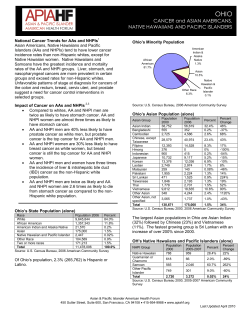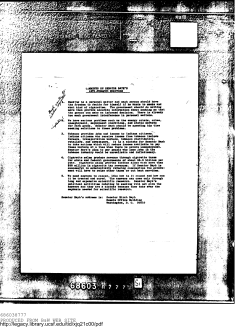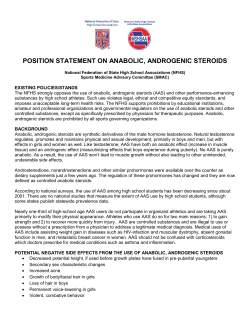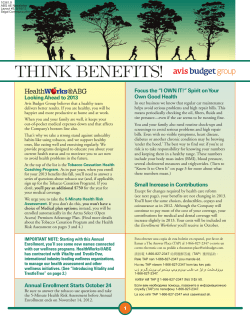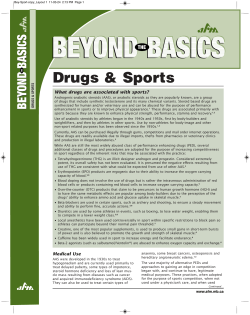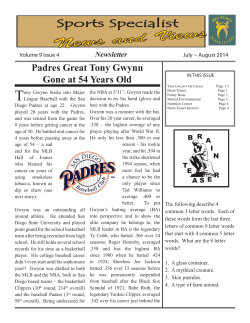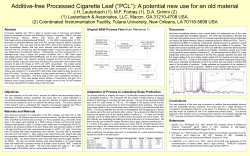
Document 3135
Health Disparities Faced by Asian Americans, Native Hawaiians and Pacific Islanders Tobacco use is the #1 preventable cause of disease, disability, and death for AAs and NHPIs. Rates of smoking prevalence for AAs nationwide are often reported as an aggregate statistic, which hides the variation between subgroups and makes it seem like AAs have the lowest smoking prevalence among all ethnic groups in the U.S. Very often, AAs & NHPIs are also presumed to have healthy body weights, masking high rates of obesity in some subgroups. DID YOU KNOW? At least 80% of premature heart disease, stroke, and type 2 diabetes could be prevented through healthy diet, regular physical activity and avoidance of tobacco products?1 However... TOBACCO USE: • Males among certain Asian American (AA) subgroups have some of the highest smoking prevalence in the United States. For example, smoking rates among AA men range from 48% among Laotians; 39% among Cambodians; 30-51% among Vietnamese; 24-25% among Filipinos; and 26-39% among Koreans.2 • Although smoking prevalence among AA women has traditionally been low, it has been increasing.2 For example, Korean and Pacific Islander women smoke at more than double the rate of all California women.3 • Aggregation of tobacco use data for Asian Americans, Native Hawaiians & Pacific Islanders (AA & NHPI) masks high prevalence of tobacco use among specific subgroups, including high prevalence among NHPI males and females.2 • Among Pacific Islanders and Southeast Asians, chewing betel nut with cigarette pieces or smokeless tobacco is a common practice, and these forms of smokeless tobacco are also linked with increased risk of cancer.2 • AA & NHPI smokers in U.S., especially youths, are more likely to smoke menthol cigarettes than the general population. More than half of AA youths and 41.4% of NHPI youths report smoking a menthol brand.4 Research shows that menthol is marketed towards communities of color and is more addictive than regular cigarettes.5 OBESITY: • Asians are at a higher risk of weight-related health issues at a lower body mass index than other ethnic groups.6 Variation within the AA subgroups reveals that Filipino adults are more than twice as likely to be obese than other AA subgroups7 and almost half of Filipinos (46%) in California are overweight or obese.8 • More than 75% of NHPIs in Hawai`i9 and more than 70% of those in California8 are overweight or obese. Many Pacific countries rank amongst the world’s highest in obesity prevalence10 and rates of overweight and obesity in adults are over 50% in at least 10 Pacific countries.11 • AAs & NHPIs have the fastest growing rate of overweight/obese children. Overweight prevalence increased more sharply for AA & NHPI low-income children than for other ethnic groups in California.12 There is an alarming epidemic of overweight/obese children in CA’s NHPI communities. For example, Samoan children have the largest percentage (54%) of children in CA whose BMI is not within the Healthy Fitness Zone. 8 Asian Pacific Partners for Empowerment, Advocacy and Leadership (APPEAL) 300 Frank H. Ogawa Plaza, #620 T: 510.272.9536 F: 510.272.0817 Oakland, CA 94612 appeal@appealforhealth.org www.appealforcommunities.org HEALTH DISPARITIES: It has been shown that greater economic and racial equality in regions also corresponds with more robust economic growth. Responsiveness to the needs of AAs and NHPIs is not just a moral imperative, but also an economic one.13 • Cancer is the leading cause of death among AAs & NHPIs.14 Lung cancer is the leading cause of cancer death for the AA & NHPI population nationwide15 and tobacco use is the number one preventable cause of death.16 PREVENTION SAVES MONEY Prevention shows a 5-to-1 return on investment. An investment of $10 per person per year in proven community-based programs to increase physical activity, improve nutrition and prevent smoking and other tobacco use could save the country more than $16 million annually within five years.23 A 2011 study showed that a 10 percent increase in local public health spending leads to significant decreases in deaths from CVD, cancer and diabetes.24 • Rates of lung cancer for Vietnamese (74.1 per 100,000), Laotian (72.5), Filipino (65.2), and Cambodian (61.0) men are higher than the California average (58.6). Koreans (49.4), Filipinos (49.1), and Vietnamese (45.2) die at a higher rate from lung cancer compared to the CA average (46.5).17 • Heart disease is the second leading cause of death among AAs & NHPIs.14 Self-reported national data suggest that diagnosed heart disease and diabetes rates amongst AA subgroups are highest among Asian Indians and Filipinos.18 • Asian Indians in Ohio have coronary artery disease prevalence rates four times that of the general U.S. population19 and cardiovascular disease (CVD) is the leading killer of Asian Indians in California.20 Filipinos and Native Hawaiians in Hawai`i have higher mortality rates due to major CVD compared to other ethnic groups. Native Hawaiians/Part-Native Hawaiians also die at a younger average age (65.2 for males, 72.3 for females) from CVD compared to other major ethnic groups.21 • Non-communicable disease mortality rates in the United States Affiliated Pacific Islands (USAPI) are among the highest in the world with hypertension prevalence at 34.2% in American Samoa, 21.2% in the Federated States of Micronesia and 15.9% in the Marshall Islands.22 SUPPORT STRATEGIES THAT WORK! Culturally competent evidence and practice-based interventions can make healthier choices the easier choices for our AA & NHPI children and families. Learn more about these strategies by: � 1. Liking us on Facebook (www.facebook.com/appealforcommunities) 2. Becoming an APPEAL Network member (sign up on www.appealforcommunities.org)! � REFERENCES FOR FACT SHEET “Health Disparities Faced by Asian Americans, Native Hawaiians and Pacific Islanders” 1. 2. 3. 4. 5. 6. 7. 8. 9. 10. 11. 12. 13. 14. 15. 16. 17. 18. 19. 20. 21. 22. 23. 24. World Health Organization. (2009). Unhealthy Diets and Physical Inactivity. Available at: http://www.who.int/nmh/ publications/fact_sheet_diet_en.pdf. Lew R. (2009). Addressing the Impact of Tobacco on Asian Americans: A Model for Change. In Bateman WB, AbesamisMendoza N, and Ho-Asjoe H (Eds.) p. 729-749. 2009 CHIS Adult Survey. Los Angeles, CA: UCLA Center for Health Policy Research, November 2011. Caraballo and Asman, “Epidemiology of Menthol Cigarette Use in the United States,” Tobacco Induced Diseases 9, Suppl 1 (2011):S1. Lee YO and Glantz SA, “Menthol: Putting the Pieces Together,” Tobacco Control 20 Suppl. 2 (2011): ii1-ii7. WHO Expert Consultation, “Appropriate Body-Mass Index for Asian Populations and its Implications for Policy and Intervention Strategies,” Lancet (2004) 363:157-63. Barnes PM, Adams PF, Powell-Griner E; Centers for Disease Control and Prevention, National Center for Health Statistics, Division of Health Interview Statistics. Health Characteristics of the Asian Adult Population: United States, 2004-2006. Advance Data from Vital Health Statistics. January 22, 2008. Issue No. 394. Ponce N, Tseng W, Ong P, Shek YL, Ortiz S, & Gatchell M (2009). The State of Asian American, Native Hawaiian and Pacific Islander Heath in California Report. Sacramento: UC AAPI Policy MRP and API Joint Legislative Caucus. Available at: http://www.cdph.ca.gov/programs/Documents/AANHPI_report_April2009.pdf. Davis J, Busch J, Hammatt Z, Novotny R, Harrigan R, Grandinetti A, Easa D. The relationship between ethnicity and obesity in Asian and Pacific Islander populations: a literature review. Ethn Dis. 2004 Winter;14(1):111-8. World Health Organization. Global Status Report on Noncommunicable Diseases 2010. Available at: http://www.who. int/nmh/publications/ncd_report_full_en.pdf. Hughes RG. World Health Organization. Diet, Food Supply and Obesity in the Pacific, 2003. Available from: http://www. wpro.who.int/NR/rdonlyres/9FEF63D8-B0EA-47D4-A394-7F7E171427EB/0/diet_food_supply_obesity.pdf. Harrison G, Kagawa-Singer M, Foerster S, Lee H, Kim LP, Nguyen T, Fernandez-Ami A, Quinn V, & Bal, DG. Seizing the Moment: California’s Opportunity to Prevent Nutrition-Related Disparities in Low-Income Asian American Populations. CANCER Supplement, 2005: 104(12): 2962-68. PolicyLink. (2012). California’s Tomorrow: Equity is the Superior Growth Model. USC Program for Environmental & Regional Equity. Available at: http://www.policylink.org/atf/cf/%7B97c6d565-bb43-406d-a6d5-eca3bbf35af0%7D/CA_ESGM_ FINAL.PDF. National Center for Health Statistics. Health, United States, 2011: With Special Feature on Socioeconomic Status and Health. Hyattsville, MD. 2012. U.S. Cancer Statistics Working Group. United States Cancer Statistics: 1999–2008 Incidence and Mortality Web-based Report. Atlanta (GA): Department of Health and Human Services, Centers for Disease Control and Prevention, and National Cancer Institute; 2012. Available at: http://www.cdc.gov/uscs. Office on Smoking and Health, National Center for Chronic Disease Prevention and Health Promotion. Smoking and Tobacco Use, Fast Facts. Available at: http://www.cdc.gov/tobacco/data_statistics/fact_sheets/fast_facts/ California’s Comprehensive Cancer Control Plan 2011-2015. Sacramento, CA: California Dialogue on Cancer, July 2011. Available at: http://www.myoc3.org/documents/CaliforniaCancerPlan2011-2015_Download.pdf Narayan KM, Aviles-Santa L, Oza-Frank R, Pandey M, Curb JD, McNeely M, Araneta MR, Palaniappan L, Rajpathak S, Barrett-Connor E; Cardiovascular Disease in Asian and Pacific Islander Populations NHLBI Working Group. Report of a National Heart, Lung, And Blood Institute Workshop: heterogeneity in cardiometabolic risk in Asian Americans In the U.S. Opportunities for research. J Am Coll Cardiol. 2010 Mar 9;55(10):966-73. Available at: http://www.sciencedirect.com/ science/article/pii/S0735109709041229. Governor’s Asian American Pacific Islander Advisory Council. (2010). A Report on the Status of Ohio’s Asian American Pacific Islander Community. Office of the Governor, State of Ohio. Available at: http://www.asiainc-ohio.org/wp-content/ uploads/2011/04/AAPI_Report_Final.pdf. Palaniappan L, Mukherjea A, Holland A, Ivey SL. Leading causes of mortality of Asian Indians in California. Ethn Dis. 2010 Winter;20(1):53-7. Balabis, J., Pobutsky, A., Kromer Baker, K., Tottori, C. & Salvail, F. The Burden of Cardiovascular Disease in Hawaii 2007. Hawaii State Department of Health, 2007. Association of Pacific Island Legislatures Board Resolution. Declaration of Regional State of Health Emergency Due to Epidemic of Non-Communicable Diseases (NCD) in the United States Affiliated Pacific Islands (USAPI). Available at: http://www.palau-health.net/images/Pacific_Island_Legislature.pdf. Trust for America’s Health. (2009). Prevention for a Healthier America: Investments in Disease Prevention Yield Significant Savings, Stronger Communities. Available at: http://healthyamericans.org/reports/prevention08/Prevention08.pdf. Mays, G.P. & Smith, S.A. (2011). Evidence Links Increases in Public Health Spending to Declines in Preventable Deaths. Health Affairs, 30(8):1585-1593.
© Copyright 2025



